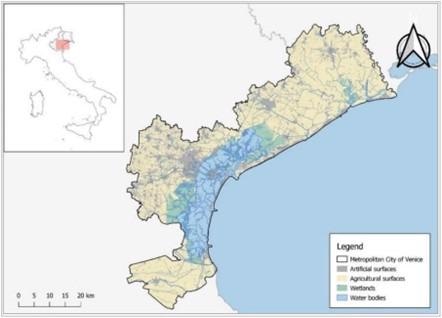Reviewed by Alex SmithMay 30 2022
Increases in climate change associated impacts are placing increasing economic, social and environmental stress on coastal regions. These climate-related hazards may be worsened by land-use transformations, sociopolitical frictions, urbanization, over-tourism, technological revolutions, and so on.
 The Metropolitan City of Venice. The Case study area. Image Credit: CMCC - UNIVE
The Metropolitan City of Venice. The Case study area. Image Credit: CMCC - UNIVE
The Metropolitan City of Venice and its lagoon, situated in the northeast of Italy, along the Adriatic coast, is a coastal-urban system that is faced with numerous challenges related both to variations in global occurrences and socioeconomic dynamics.
With the aim of improving the resilience of the entire system to various climate-related disasters and a range of other stressors, researchers at CMCC@Ca’Foscari, the strategic collaboration between CMCC Foundation and Ca’ Foscari University of Venice, have been involved in a study that finds the best risk management initiatives for the region.
Given the background of high improbability caused by climate change, the key objective was to find strong initiatives across a variety of probable future scenarios.
The Prioritization of Resilience Initiatives for Climate-Related Disasters in the Metropolitan City of Venice study has been carried out in the context of ‘BRIDGE’, a project of great significance for the collaboration between Italy and the United States, organized by Andrea Critto, Professor at Ca’Foscari University of Venice and senior scientist at the CMCC.
It deduces that, given the state of improbability, the best imaginable strategy is to use a range of risk-management initiatives — rather than a single initiative — to improve the resilience of the entire system.
This collection of measures should comprise physical initiatives — such as the alteration of hydraulic defense structures to handle large scale and strong events — along with social and cognitive initiatives — such as modernizing and executing plans and regulations — which can be versatile enough to be operational against a variety of hazards.
The research incorporates qualitative data — extracted from the participation of stakeholders in a workshop — and quantitative data extracted from climate sciences (i.e., climate-change projections).
At first, various groups of regional stakeholders, including regional authorities, parks, research institutions, civil protection agencies, and NGOs identified the important components of the system (natural, social, cultural, and economic) that should be safeguarded in the region.
Next, experts and stakeholders identified a series of policy initiatives to assist these important functions and separated them into four groups.
Information initiatives (early warning platforms and data production and sharing); physical initiatives (blue and green infrastructure networks, adaptation and improvement of the water network and supply, alteration of hydraulic defense structures and emergency response systems); cognitive initiatives (updating and executing plans and regulations and civil protection machine planning; as well as strategies and plans for recovery and restoration of historical places); and social initiatives (environmental education and consciousness and citizen science).
Finally, the abovementioned risk management initiatives were ranked, via a scenario-informed MultiCriteria Decision Analysis (MCDA), across four situations illustrating key climate threats anticipated in the area: heatwaves, storm surges, pluvial floods, and drought.
Results reveal that various climate scenarios when examined independently, lead to a particular prioritization of the series of risk management initiatives. Similarly, the priority of initiatives varies when considering the combined occurrence of many scenarios.
However, given the large ambiguity in envisaging which threat scenarios may happen in the future in this particular region, the ideal option is to construct the overall resilience of coastal systems in the face of a variety of hostile events.
The management substitutes working on the physical domain, regardless of being considered a priority by stakeholders, usually only improve resilience covering a few situations. These outcomes can be described by the fact that physical initiatives are typically developed and executed by targeting very precise typologies of extreme climate events.
For instance, the design of hydraulic defense arrangements and the execution of emergency response preparations including set infrastructural projects such as the MOSE - (MOdulo Sperimentale Elettromeccanico) or temporary solutions (e.g., pumps, footbridges, and mobile bulkheads on private doors and buildings) - are specially developed for the protection of the Metropolitan City of Venice from high waters events and storm surge, while lacking any ability to boost the system resilience concerning other types of hazard, such as heatwaves and drought.
In contrast, informative, cognitive, and social initiatives appear to be more stable under varying conditions, as they preserve their position when climate change situations occur.
implementing initiatives powerfully oriented to handling specific threats could result in an increase of risk toward other kinds of threats (i.e., maladaptation), thus compromising efforts and resources invested in threat reduction.
Therefore, the study suggests the acceptance of a range of risk-management initiatives to improve the system’s resilience. These must comprise physical initiatives to handle large-scale and powerful events, along with social and cognitive ones which can be versatile enough to be effective against a variety of threats.
Climate risks are interconnected and do not occur in isolation. If we don’t employ a multi-risk approach in the assessment and management of risks, we could adopt measures that address one problem but generate or amplify others.
Silvia Torresan, Co-Director, Risk Assessment and Adaptation Strategies Division, CMCC Foundation
Journal Reference:
Bonato, M., et al. (2022) Prioritization of Resilience Initiatives for Climate-Related Disasters in the Metropolitan City of Venice. Risk Analysis. doi.org/10.1111/risa.13823.